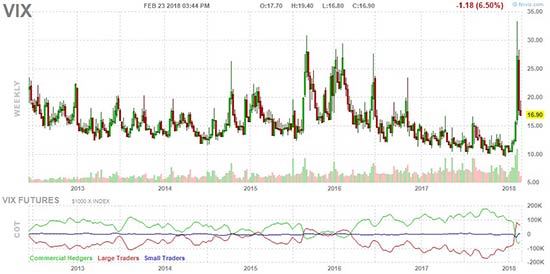Volatility is front and center again after U.S. President Donald Trump said he would impose new steel and aluminum tariffs, the first shot in what looks like an all-out global trade war on the horizon.
Now, I've spent more than two decades in the markets. I primarily stick to investing these days and use techniques similar to those of leading private equity funds to find unreasonably priced bargain securities that stand the best chance of making me a pile of money.
But I'm no stranger to trading. Most of my trades are related to arbitrage, but they've also occasionally forayed into options and futures.
More importantly, my drinking and dining companions in New York and Chicago include some outrageously successful traders. In Chicago, these are mostly option traders.
Most of them share two common traits: an unnatural ability to consume expensive booze, and the tendency to forget more math before breakfast than most of us will ever learn.
All of them understand volatility in their trading. And unlike most retail investors and traders out there, they actually know how to use it.
The tragedy is, if you're a regular investor, even one that's doing your own trading, you don't have to come within 50 miles of the VIX to make money when things get shaky. Here's what I mean...
Ask Five Retail Investors to Define Volatility - You'll Get Five Different Answers
I have talked to a lot of folks in the past year who tell me they are trading volatility. Most aren't doing it with recommendations from research services like Money Map Press. They're on their own.
Some say they use the fancy exchange-traded notes (ETNs) that track the direction of the CBOE Volatility Index (VIX), while others use options on the VIX, and a few brave souls even use VIX futures.
TOP PERFORMANCE: This man showed his paid-up subscribers 589.63% in total winning moves, closed over just five days in January. And he's offering a stunning performance guarantee for those who get in now. Click here...
I always ask them what the VIX is and I get answers like... "a sentiment index," "a measure of big money options trading activity," and "a fear and greed measurement."
All of these sound okay, for a "layman's terms"-style explanation, and there is what you might call a kernel of truth there, but they're missing the fundamental truth.
And a miss is as good as a mile when this much high-powered algebra and money are concerned.
[mmpazkzone name="in-story" network="9794" site="307044" id="137008" type="4"]
They are trading this stuff, and they don't have a clue about what it is, or, more importantly, how it works.
According to the CBOE, the VIX is "a measure of expected volatility calculated as 100 times the square root of the expected 30-day variance of the S&P 500 rate of return."
In terms of how it's calculated, the VIX is 100 times the square root of the 30-day variance of two option strips based on the S&P 500 index. The option strips used are the strike right below the current price and the next strike above the price.
Still with me? Good - but you won't be once I lay this algebra on you.
This is how we calculate that 30-day variance of the two options strips, as explained on the CBOE website...

Once we have that, we can find the VIX value with this "simple" math...

Keep in mind that those option strips also are priced using some interesting math. The basic Black-Scholes model uses inputs like current price, price movement, and interest rates to drive the value of puts and calls.
I will save you the exact calculation, but trust me when I tell you that it is every bit as complicated as the VIX math, with more Greek than you'd get during a rough night on Santorini.
This is what those brave, intrepid adventurers are doing: trading options or ETNs based on which way this extremely complicated beast moves.
They are making a fourth-layer bet on how the derived prices of S&P 500 options will move and how that movement will cause the variance measurement of those options to change. They need to calculate how much the movement on the S&P will move those options, how much the movement of the options will move the VIX, and finally, how much the movement in the VIX will move the price of whichever derivative they decided they knew how to trade.
I will never understand what the hell is wrong with those people.
These trades are more complex than the trades that blew up Long-Term Capital Management (LTCM), and that fund was led by economists including Myron Scholes, the same guy who put the "Scholes" in "Black-Scholes options pricing model."
I mean, those guys were actual rocket scientists, and when the mathematical relationship between instruments they traded shifted momentarily, they lost billions of dollars and damn near blew up the global banking system along the way.
Yet those VIX traders, in all their wisdom, think they can draw a line on a chart and trade something this complex.
Here's the hard truth: Even the creators of the VIX and its trading products think they've lost their minds for trying this stuff.
Bob Whaley, a finance professor at Vanderbilt University who helped develop the index, said late last year, "I don't think people understand it as well as they should. The VIX doesn't trade. It's just a number produced from these 250 S&P 500 option prices. But what does trade are the VIX futures and the VIX options, which are related to VIX but in a strange way. Where VIX is the volatility over the next 30 days, VIX futures is the expectation of the volatility 30 days from now. Those two series don't behave like one another, in fact they're quite different."
Unless they have that higher math degree, most common folk don't understand the basic index calculation. They sure as hell don't understand the pricing of the derivative instrument they're using to trade the underlying volatility index.
The fund sponsor of the product will make money. The broker will make money. The clueless investor probably will not.
And that goes for shorting it, too...
This Chart Will Convince You to Never Short the VIX Again
I have talked with a lot of people who were short volatility or owned inverse VIX products over the past few months, and they're all licking some wounds. A couple associates of mine even had to get out of the game because they were short volatility when it spiked.
Look at this chart of the VIX over the last five years. (Here's a spoiler: It looks like nothing so much as a bed of nails.)

Again, I don't trade much these days, but what about the VIX's history of fast, skyrocketing spikes from record lows makes you want to short it?
If there's a clearer picture of picking up pennies in front of a steamroller, I haven't seen it.
Fortunately, there's a right way to bet on volatility - and it's got nothing to do with the VIX. It's sane and involves no algebra whatsoever.
Here's What to Do Instead
If you absolutely must bet on volatility, bet an out-of-the-money straddle on your favorite stock or the S&P 500 itself when you're convinced volatility will explode. Use the next strike up and the next strike down. If you think that volatility is about to collapse, sell put spreads, again using the index or your favorite stocks.
In both cases, if you are right, you'll make some money and have bragging rights at the club this weekend.
More importantly, if you are wrong, you won't lose very much.
Andrew Lo, of MIT, is widely regarded as one of the more brilliant finance professors alive today. He once said that the most important job for the long-term investor is to survive for the long term.
No need to make that already monumental task even more difficult by trading something you don't understand.
Next Up: Each of These Big Eruptions Was Spotted 48 Hours in Advance
Chris Johnson's "price eruption" recommendations are off to an incredible start this year: 153.59% with FCAU on Jan. 8... 56.70% with ADBE on Jan. 8... 102.78% with OZRK on Jan. 11... and then an additional 276.47% on FCAU on Jan. 12.
That's 589.63% total winning moves in just five days! Right now, he's tracking dozens of opportunities that could uncover serious cash - fast. And he's offering a stunning performance guarantee, too. Go here now to see how this works...
Follow Money Morning on Twitter @moneymorning, Facebook, and LinkedIn.
About the Author
Tim Melvin is an unlikely investment expert by any measure. Raised in the "projects" of Baltimore by a single mother, he never attended college and started out as a door-to-door vacuum salesman. But he knew the real money was in the stock market, so he set sights on investing - and by sheer force of determination, he eventually became a financial advisor to millionaires. Today, after 30 years of managing money for some of the wealthiest people in the world, he draws on his experience to help investors find "unreasonably good" bargain stocks, multiply profits, and build their nest eggs. Tim tirelessly works to find overlooked "hidden gems" in the stock market, drawing on the research of legendary investors like Benjamin Graham, Walter Schloss, and Marty Whitman. He has written and lectured extensively on the markets, with work appearing on Benzinga, Real Money, Daily Speculations, and more. He has published several books in the "Little Book of" Investment Series and a "Junior Chamber Course" geared towards young adults that teaches Graham's principles and techniques to a new generation of investors. Today, he serves as the Special Situations Strategist at Money Morning and the editor of Peak Yield Investor.



